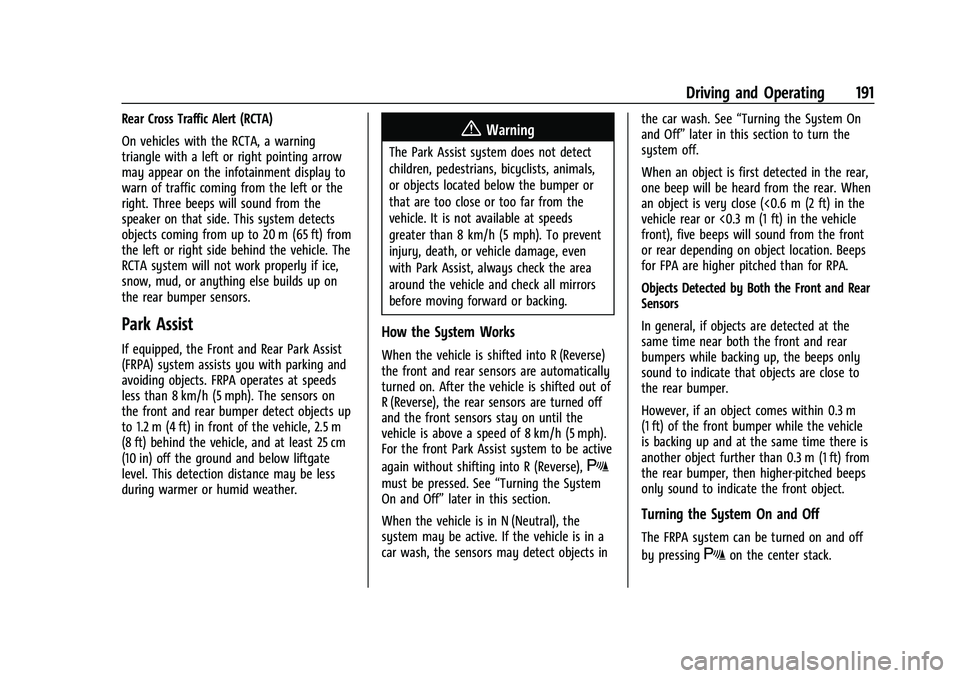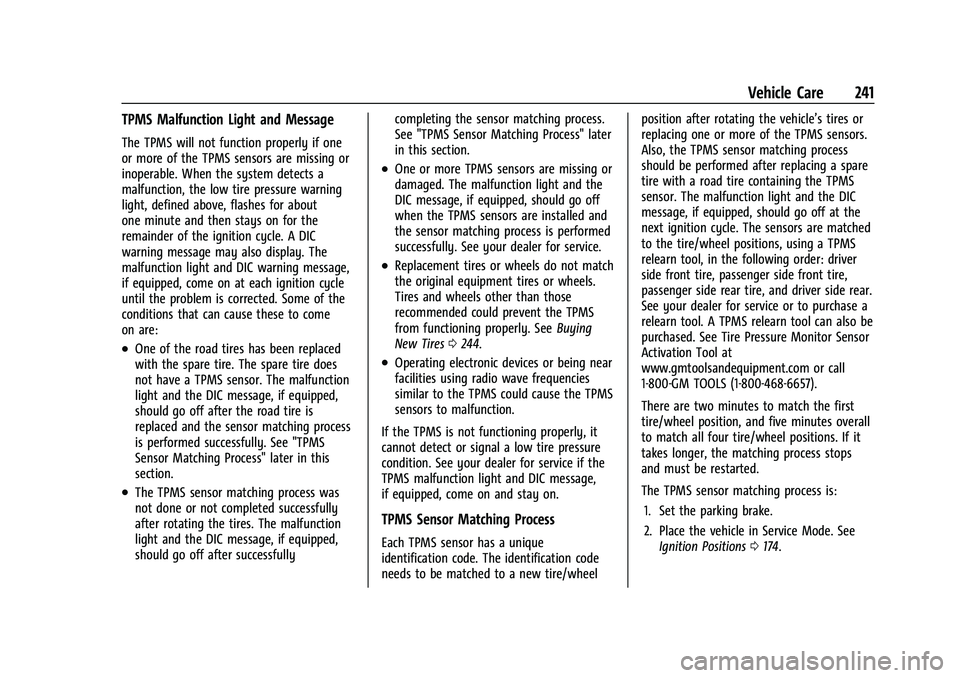parking sensors BUICK ENCORE 2021 Owner's Manual
[x] Cancel search | Manufacturer: BUICK, Model Year: 2021, Model line: ENCORE, Model: BUICK ENCORE 2021Pages: 313, PDF Size: 11.21 MB
Page 192 of 313

Buick Encore Owner Manual (GMNA-Localizing-U.S./Canada-14607636) -
2021 - CRC - 8/18/20
Driving and Operating 191
Rear Cross Traffic Alert (RCTA)
On vehicles with the RCTA, a warning
triangle with a left or right pointing arrow
may appear on the infotainment display to
warn of traffic coming from the left or the
right. Three beeps will sound from the
speaker on that side. This system detects
objects coming from up to 20 m (65 ft) from
the left or right side behind the vehicle. The
RCTA system will not work properly if ice,
snow, mud, or anything else builds up on
the rear bumper sensors.
Park Assist
If equipped, the Front and Rear Park Assist
(FRPA) system assists you with parking and
avoiding objects. FRPA operates at speeds
less than 8 km/h (5 mph). The sensors on
the front and rear bumper detect objects up
to 1.2 m (4 ft) in front of the vehicle, 2.5 m
(8 ft) behind the vehicle, and at least 25 cm
(10 in) off the ground and below liftgate
level. This detection distance may be less
during warmer or humid weather.
{Warning
The Park Assist system does not detect
children, pedestrians, bicyclists, animals,
or objects located below the bumper or
that are too close or too far from the
vehicle. It is not available at speeds
greater than 8 km/h (5 mph). To prevent
injury, death, or vehicle damage, even
with Park Assist, always check the area
around the vehicle and check all mirrors
before moving forward or backing.
How the System Works
When the vehicle is shifted into R (Reverse)
the front and rear sensors are automatically
turned on. After the vehicle is shifted out of
R (Reverse), the rear sensors are turned off
and the front sensors stay on until the
vehicle is above a speed of 8 km/h (5 mph).
For the front Park Assist system to be active
again without shifting into R (Reverse),
X
must be pressed. See“Turning the System
On and Off” later in this section.
When the vehicle is in N (Neutral), the
system may be active. If the vehicle is in a
car wash, the sensors may detect objects in the car wash. See
“Turning the System On
and Off” later in this section to turn the
system off.
When an object is first detected in the rear,
one beep will be heard from the rear. When
an object is very close (<0.6 m (2 ft) in the
vehicle rear or <0.3 m (1 ft) in the vehicle
front), five beeps will sound from the front
or rear depending on object location. Beeps
for FPA are higher pitched than for RPA.
Objects Detected by Both the Front and Rear
Sensors
In general, if objects are detected at the
same time near both the front and rear
bumpers while backing up, the beeps only
sound to indicate that objects are close to
the rear bumper.
However, if an object comes within 0.3 m
(1 ft) of the front bumper while the vehicle
is backing up and at the same time there is
another object further than 0.3 m (1 ft) from
the rear bumper, then higher-pitched beeps
only sound to indicate the front object.
Turning the System On and Off
The FRPA system can be turned on and off
by pressing
Xon the center stack.
Page 242 of 313

Buick Encore Owner Manual (GMNA-Localizing-U.S./Canada-14607636) -
2021 - CRC - 8/18/20
Vehicle Care 241
TPMS Malfunction Light and Message
The TPMS will not function properly if one
or more of the TPMS sensors are missing or
inoperable. When the system detects a
malfunction, the low tire pressure warning
light, defined above, flashes for about
one minute and then stays on for the
remainder of the ignition cycle. A DIC
warning message may also display. The
malfunction light and DIC warning message,
if equipped, come on at each ignition cycle
until the problem is corrected. Some of the
conditions that can cause these to come
on are:
.One of the road tires has been replaced
with the spare tire. The spare tire does
not have a TPMS sensor. The malfunction
light and the DIC message, if equipped,
should go off after the road tire is
replaced and the sensor matching process
is performed successfully. See "TPMS
Sensor Matching Process" later in this
section.
.The TPMS sensor matching process was
not done or not completed successfully
after rotating the tires. The malfunction
light and the DIC message, if equipped,
should go off after successfullycompleting the sensor matching process.
See "TPMS Sensor Matching Process" later
in this section.
.One or more TPMS sensors are missing or
damaged. The malfunction light and the
DIC message, if equipped, should go off
when the TPMS sensors are installed and
the sensor matching process is performed
successfully. See your dealer for service.
.Replacement tires or wheels do not match
the original equipment tires or wheels.
Tires and wheels other than those
recommended could prevent the TPMS
from functioning properly. See
Buying
New Tires 0244.
.Operating electronic devices or being near
facilities using radio wave frequencies
similar to the TPMS could cause the TPMS
sensors to malfunction.
If the TPMS is not functioning properly, it
cannot detect or signal a low tire pressure
condition. See your dealer for service if the
TPMS malfunction light and DIC message,
if equipped, come on and stay on.
TPMS Sensor Matching Process
Each TPMS sensor has a unique
identification code. The identification code
needs to be matched to a new tire/wheel position after rotating the vehicle’s tires or
replacing one or more of the TPMS sensors.
Also, the TPMS sensor matching process
should be performed after replacing a spare
tire with a road tire containing the TPMS
sensor. The malfunction light and the DIC
message, if equipped, should go off at the
next ignition cycle. The sensors are matched
to the tire/wheel positions, using a TPMS
relearn tool, in the following order: driver
side front tire, passenger side front tire,
passenger side rear tire, and driver side rear.
See your dealer for service or to purchase a
relearn tool. A TPMS relearn tool can also be
purchased. See Tire Pressure Monitor Sensor
Activation Tool at
www.gmtoolsandequipment.com or call
1-800-GM TOOLS (1-800-468-6657).
There are two minutes to match the first
tire/wheel position, and five minutes overall
to match all four tire/wheel positions. If it
takes longer, the matching process stops
and must be restarted.
The TPMS sensor matching process is:
1. Set the parking brake.
2. Place the vehicle in Service Mode. See Ignition Positions 0174.